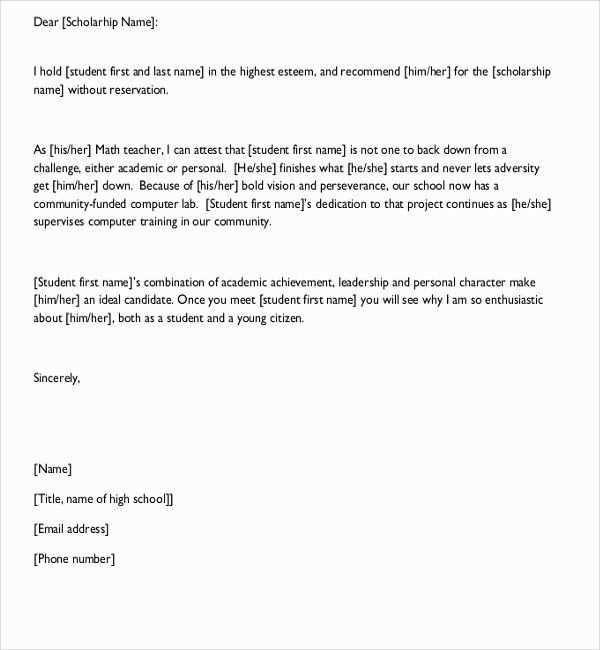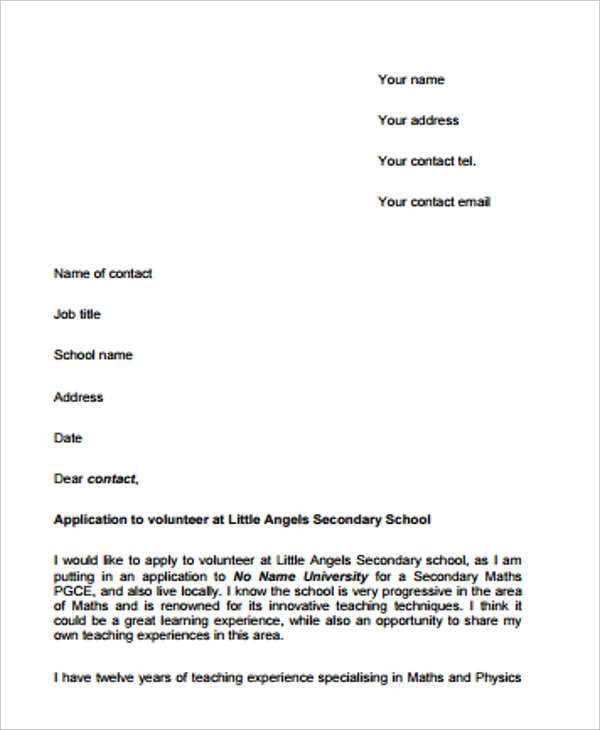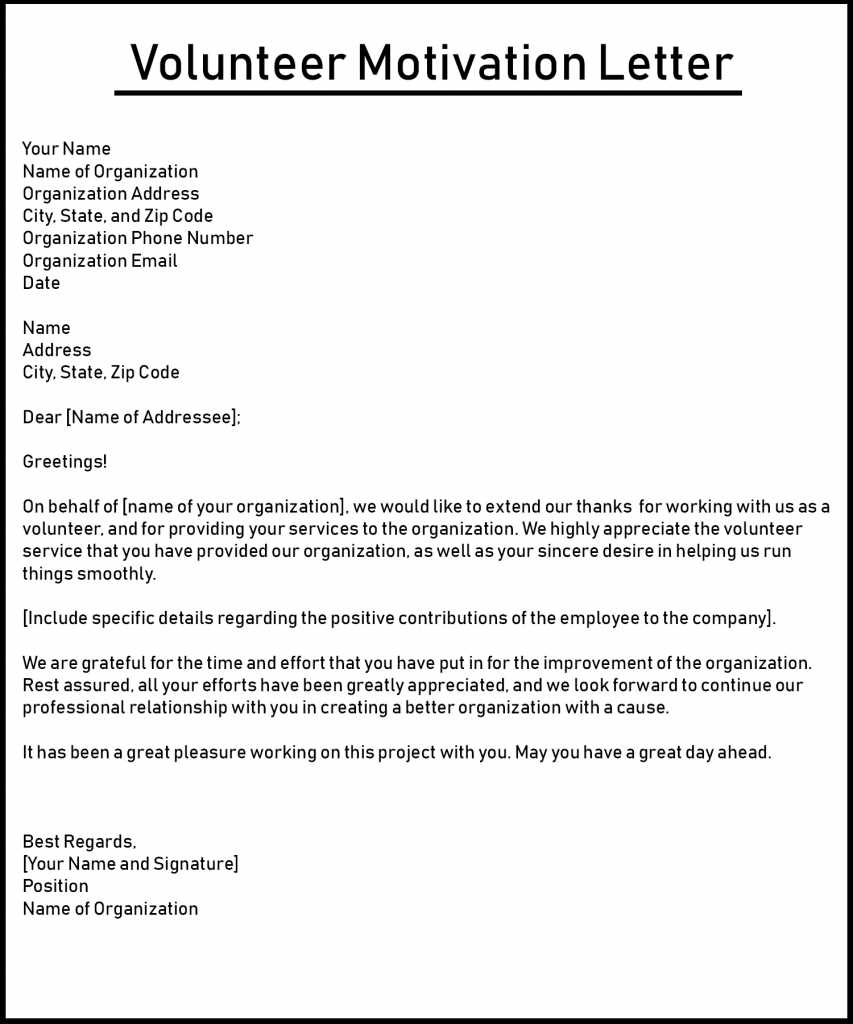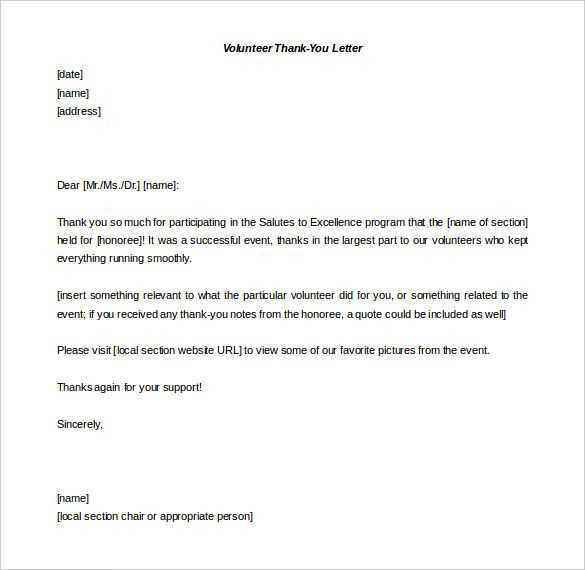Volunteer template letter

When writing a volunteer letter, be direct and clear about your intention. Make sure to express your passion for the cause you’re supporting and mention how your skills align with the organization’s needs. A well-crafted letter not only introduces you as a potential volunteer but also highlights your commitment and enthusiasm to make a difference.
Start by addressing the person or department responsible for volunteer coordination. If you don’t have a specific contact, use a general salutation like “Dear Volunteer Coordinator.” Keep your tone friendly but professional, and immediately state why you’re interested in volunteering. Mention any relevant experience or skills that can contribute to the organization’s mission.
In the next section, provide more details about your availability and the type of volunteer work you’re interested in. Let the organization know how often and when you can volunteer, and express your willingness to work on a flexible schedule if needed. Offering some suggestions on how you can help can show initiative and help guide the organization in their decision-making process.
Finish the letter with a strong closing statement, reiterating your eagerness to contribute and thanking the reader for considering your offer. A polite thank you, followed by a sign-off, leaves a positive impression and encourages further communication.
Here’s the revised version:
Begin with a clear statement of your intent to volunteer. Outline the specific tasks or roles you are interested in. Provide brief details about your skills or experiences that make you a suitable candidate for these tasks.
Example Template:
Dear [Organization Name],
I am writing to express my interest in volunteering with your organization. I have [mention skills/experience] and am eager to contribute to [specific task/role]. I believe my background in [mention relevant experience] will be valuable in supporting your efforts.
I am available to volunteer [mention availability] and look forward to discussing how I can assist you further. Please feel free to contact me at [phone number/email] if you have any questions or need more information.
Thank you for considering my application. I look forward to the opportunity to contribute to your mission.
Sincerely,
[Your Name]
Key Elements to Include:
- Clear intent to volunteer
- Specific role or task you’re interested in
- Relevant skills or experiences
- Availability details
- Contact information
- Volunteer Letter Template
To create a clear and professional volunteer letter, focus on providing relevant details, maintaining a friendly tone, and conveying your message in a concise manner. A well-structured volunteer letter can make a strong impact and help build positive relationships with the organization or recipient.
Structure of a Volunteer Letter

The letter should be broken down into key sections for easy readability:
| Section | Description |
|---|---|
| Introduction | Begin with a friendly greeting, stating the purpose of your letter. Mention how you came across the volunteer opportunity and your excitement to contribute. |
| Skills and Experience | Highlight relevant skills, past volunteer experiences, or specific qualities that align with the organization’s mission. |
| Commitment and Availability | Specify your availability and the time commitment you’re willing to offer. Be clear about your flexibility and willingness to adjust. |
| Closing | Conclude by expressing gratitude for the opportunity. Mention how you look forward to working together and include contact information for follow-up. |
Sample Volunteer Letter
Dear [Recipient’s Name],
I am writing to express my interest in volunteering with [Organization Name]. After learning about the impactful work you’re doing, I am excited to contribute my time and skills to support your mission.
I bring [mention relevant skills or experiences] and have volunteered with [previous volunteer roles] in the past. I am confident that my background will allow me to make meaningful contributions to your organization.
I am available [mention your availability], and I am open to adjusting my schedule to accommodate any urgent needs you might have.
Thank you for considering my application. I am eager to join your team and look forward to hearing from you. Please feel free to contact me at [your contact information] for any further information.
Sincerely,
[Your Name]
To create a strong volunteer letter, focus on a warm, approachable tone. Avoid being too formal or too casual. A friendly but respectful approach will help the recipient feel comfortable and valued. Begin with a positive statement that clearly expresses your intent and interest in contributing to their cause.
Adjusting Tone Based on the Audience
Consider the recipient of your letter. If you’re addressing a community organization, use a tone that conveys enthusiasm and a genuine desire to help. For a more formal organization, maintain professionalism but keep it warm and welcoming. Tailoring your language to fit the specific audience will increase your chances of making a positive impression.
Keeping it Clear and Sincere
Clarity is key. Be direct in explaining your availability, skills, and why you’re interested in volunteering. Avoid overloading the letter with unnecessary details. Stay sincere and show genuine interest in the cause or event you’re supporting. This will establish trust and highlight your commitment.
Clearly state the purpose of your letter at the beginning. Mention your interest in the volunteer position and explain how your skills and experiences align with the organization’s goals.
Contact Information
Provide your full name, address, phone number, and email. This allows the recipient to reach you quickly if necessary. If the organization has a specific contact person, address the letter to them directly.
Your Availability

Clearly outline your availability, including days and times you can commit to. This will help the organization assess your fit for their needs. Specify if you’re looking for short-term or long-term opportunities.
Relevant Experience and Skills
Highlight any previous volunteer work or relevant skills that demonstrate your ability to contribute. This could include leadership, communication, or organizational skills, as well as specific experience related to the role.
Motivation and Commitment
Explain why you want to volunteer with this organization. Show your understanding of their mission and how your involvement can contribute to their objectives. This adds a personal touch and demonstrates genuine interest.
References

If applicable, provide references who can vouch for your work ethic and character. Include the reference’s name, title, and contact details. Be sure to ask permission before listing someone as a reference.
Closing Statement

Conclude your letter by expressing your enthusiasm for the opportunity. Thank the recipient for considering your application and indicate your willingness to discuss further details. End with a professional closing, such as “Sincerely” or “Best regards.”
| Information to Include | Details |
|---|---|
| Contact Information | Your name, phone, and email |
| Availability | Specific days and times |
| Relevant Experience | Previous volunteer roles, skills |
| Motivation | Why you want to volunteer |
| References | Names, contact details |
| Closing Statement | Express gratitude and interest |
Research the organization’s mission, values, and recent projects before you begin writing. Show how your skills and experiences align with their goals. This not only demonstrates your interest but also positions you as someone who is genuinely invested in their work.
Tailor Your Introduction
Craft your introduction to highlight how you first learned about the organization. Mention any mutual connections or specific initiatives that resonate with you. This establishes a personal connection right away.
Address the Specific Needs of the Organization
Every organization has different priorities. For example, if one focuses on education, emphasize your teaching or mentoring experience. For environmental groups, showcase any eco-friendly initiatives you’ve been a part of. Show that you understand their focus and that your contribution will be aligned with their objectives.
Adjust the tone of your letter based on the organization’s culture. Some might appreciate a formal approach, while others may value a more casual and approachable tone. Research how they communicate through their website or social media to get a sense of their style.
Close by reiterating why you’re excited about the opportunity to volunteer with them and how your unique qualities can support their mission.
Keep your letter clear and focused by avoiding these common errors:
- Overcomplicating the language: Stick to simple and direct language. Avoid jargon or overly formal terms that may confuse the reader.
- Ignoring the recipient’s preferences: Customize your tone and style to suit the person you’re addressing. A formal tone may be necessary for official letters, while a friendly approach works best for volunteer requests.
- Skipping the purpose: State your purpose early. Avoid burying your main message in the middle of the letter. Be clear about your reason for writing.
- Being too vague: Provide specific details and examples. Don’t leave the reader guessing about your intentions or background.
- Lengthy paragraphs: Break your content into shorter, more readable paragraphs. Long blocks of text are hard to follow and may cause the reader to lose interest.
- Forgetting the call to action: End your letter with a clear request or next step. Let the reader know what you expect them to do after reading your letter.
- Spelling and grammar mistakes: Always proofread your letter. Mistakes can undermine your credibility and make your message harder to understand.
Begin with a clear and consistent layout. Use a simple, professional font like Arial or Times New Roman, sized between 10 and 12 points for readability. Make sure your margins are set to 1 inch on all sides.
- Align text properly: Keep your text aligned to the left, without justifying it. This helps with readability and keeps your letter looking neat.
- Spacing: Leave a line between each section: your address, the date, the recipient’s address, salutation, body paragraphs, and closing. Double-space the body to create visual separation.
- Headers: Include your contact information at the top, followed by the date and the recipient’s information. This is the standard business letter format.
- Salutation: Use “Dear [Recipient’s Name]” for formal letters. Avoid overly casual greetings like “Hey” or “Hello.” If you’re unsure about the recipient’s title, use “Dear Sir/Madam.”
- Closing: Finish with a polite closing phrase such as “Sincerely,” or “Best regards,” followed by your name. Keep it professional and avoid casual phrases.
- Proofread: Always review your letter for grammar and spelling errors. A clean, error-free letter will make a stronger impact.
These tips ensure that your volunteer letter maintains a polished and professional look, improving the chances of making a positive impression.
Wait for about a week before following up. This gives the recipient time to review your letter and take any necessary actions. If you haven’t received a response, send a polite reminder. Keep your message concise and professional, briefly referencing your initial letter and expressing continued interest in the opportunity to volunteer.
Be sure to choose the right communication method. If you sent the letter by email, follow up via email as well. For physical mail, consider making a phone call to confirm the letter was received. Adjust your tone based on the method, ensuring you remain respectful and friendly.
Always keep your follow-up messages positive. Acknowledge that the recipient may be busy and offer to provide additional information if needed. Reiterate your enthusiasm for volunteering and your willingness to contribute.
Lastly, if you do not hear back after the follow-up, respect the recipient’s decision. Some opportunities may not be available immediately, or there might be other candidates. Maintain a positive relationship for future opportunities.
Volunteer Template Letter
A volunteer template letter should clearly state the purpose and expectations of the volunteer role. Start with a greeting, addressing the recipient by name whenever possible. Ensure the tone is friendly but professional, as this will establish a positive relationship right from the start.
Structure of the Letter
Begin by introducing yourself or the organization you represent. Clearly mention the reason for writing and provide a brief description of the volunteer opportunity. Mention the specific tasks or responsibilities the volunteer will be expected to undertake. If there are any important dates or deadlines, include them here.
Closing the Letter
End the letter with a call to action, inviting the recipient to contact you for further details or to confirm their participation. Be sure to express your gratitude and appreciation for their time and consideration. Keep the closing professional and respectful.